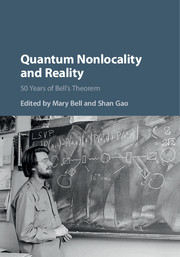Book contents
- Frontmatter
- Contents
- Contributors
- Preface
- Preface
- Part I John Stewart Bell: The Physicist
- Part II Bell's Theorem
- 4 What Did Bell Really Prove?
- 5 The Assumptions of Bell's Proof
- 6 Bell on Bell's Theorem: The Changing Face of Nonlocality
- 7 Experimental Tests of Bell Inequalities
- 8 Bell's Theorem without Inequalities: On the Inception and Scope of the GHZ Theorem
- Part III Nonlocality: Illusion or Reality?
- Part IV Nonlocal Realistic Theories
- Index
- References
7 - Experimental Tests of Bell Inequalities
from Part II - Bell's Theorem
Published online by Cambridge University Press: 05 September 2016
- Frontmatter
- Contents
- Contributors
- Preface
- Preface
- Part I John Stewart Bell: The Physicist
- Part II Bell's Theorem
- 4 What Did Bell Really Prove?
- 5 The Assumptions of Bell's Proof
- 6 Bell on Bell's Theorem: The Changing Face of Nonlocality
- 7 Experimental Tests of Bell Inequalities
- 8 Bell's Theorem without Inequalities: On the Inception and Scope of the GHZ Theorem
- Part III Nonlocality: Illusion or Reality?
- Part IV Nonlocal Realistic Theories
- Index
- References
Summary
Introduction
Annus mirabilis 1964
1964 was a wonderful year for physics. In this annus mirabilis, summarising and simplifying a little, the quark model was proposed by Gell-Mann and Zweig and charm and colour properties were introduced, Higgs published his work on the scalar boson, the _ boson and CP violation were discovered, cosmic background radiation was identified and, finally, Bell inequalities were suggested.
Most of these works were later subjects of a Nobel prize. Unluckily John Bell left us too early for this achievement, but, at least in my opinion, his work [1] is probably the most fruitful among all these huge advances, since now we can recognise that it was the root of a fundamental change in our vision of the physical world, providing, on one hand, the possibility of a test of quantum mechanics against a whole class of theories (substantially all the theories that we could define as “classical”) and, on the other hand, introducing a clear notion of quantum nonlocality that represents not only a challenge in understanding quantum mechanics, but also one of the most important resources paving the way to quantum technologies that were developed in the last decades based on the quantum correlations discussed in the Bell paper.
In the following we will present the experimental progress in testing Bell inequalities. Rather amazingly even 50 years after Bell's paper, a conclusive test of his proposal is still missing [2, 3].
Nevertheless, huge progress has been achieved with respect to the first experiments.We will discuss these developments and the remaining problems for a conclusive test of Bell inequalities in detail.
The Bell Inequalities, Their Hypotheses and the Experimental Loopholes
In order to understand the experimental difficulties in achieving a final test of Bell inequalities, let us analyse a little how these inequalities are derived and the explicit and implicit hypotheses they contain.
The proof of Bell inequalities usually starts by considering two separated subsystems of an entangled state, which are addressed to two independent measurement apparatuses measuring the expectation values of two dichotomic observables, Aa and Bb. a, b are two parameters describing the settings of the measuring apparatus A and B, respectively.
- Type
- Chapter
- Information
- Quantum Nonlocality and Reality50 Years of Bell's Theorem, pp. 124 - 140Publisher: Cambridge University PressPrint publication year: 2016
References
- 1
- Cited by



